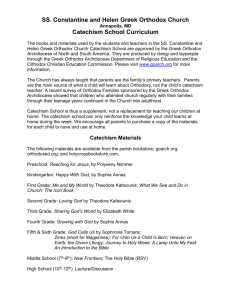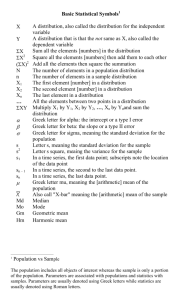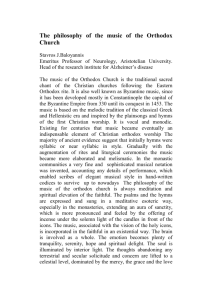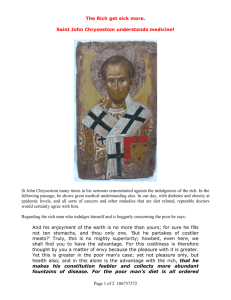The First Clergy-Laity Congress in 1921
advertisement
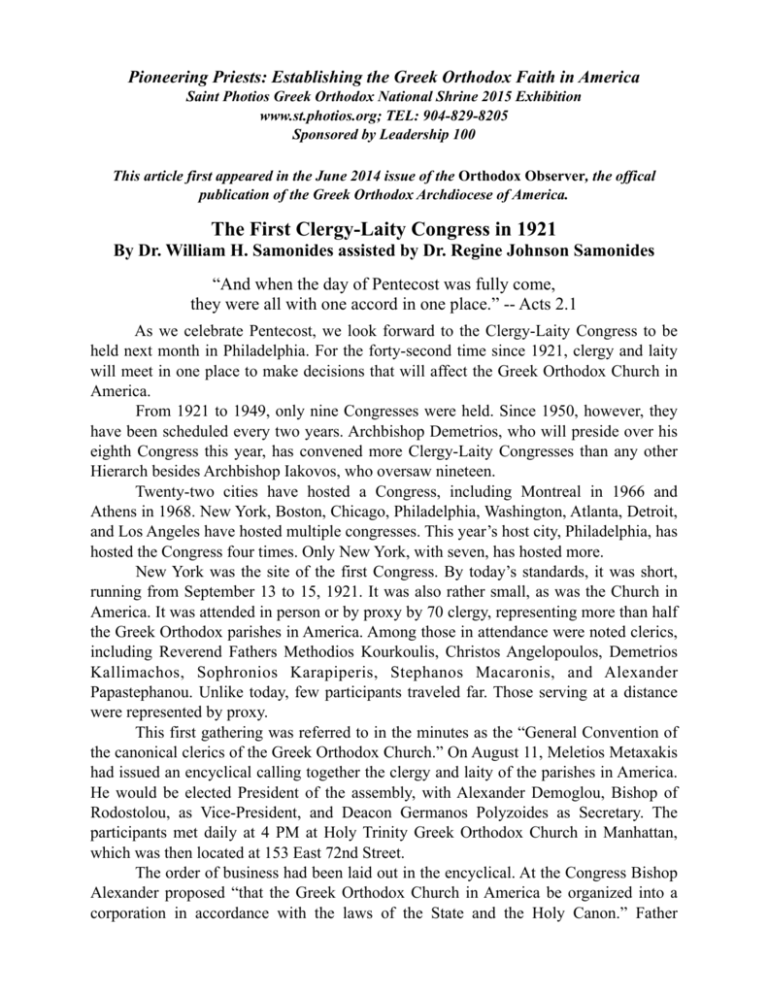
Pioneering Priests: Establishing the Greek Orthodox Faith in America Saint Photios Greek Orthodox National Shrine 2015 Exhibition www.st.photios.org; TEL: 904-829-8205 Sponsored by Leadership 100 This article first appeared in the June 2014 issue of the Orthodox Observer, the offical publication of the Greek Orthodox Archdiocese of America. The First Clergy-Laity Congress in 1921 By Dr. William H. Samonides assisted by Dr. Regine Johnson Samonides “And when the day of Pentecost was fully come, they were all with one accord in one place.” -- Acts 2.1 As we celebrate Pentecost, we look forward to the Clergy-Laity Congress to be held next month in Philadelphia. For the forty-second time since 1921, clergy and laity will meet in one place to make decisions that will affect the Greek Orthodox Church in America. From 1921 to 1949, only nine Congresses were held. Since 1950, however, they have been scheduled every two years. Archbishop Demetrios, who will preside over his eighth Congress this year, has convened more Clergy-Laity Congresses than any other Hierarch besides Archbishop Iakovos, who oversaw nineteen. Twenty-two cities have hosted a Congress, including Montreal in 1966 and Athens in 1968. New York, Boston, Chicago, Philadelphia, Washington, Atlanta, Detroit, and Los Angeles have hosted multiple congresses. This year’s host city, Philadelphia, has hosted the Congress four times. Only New York, with seven, has hosted more. New York was the site of the first Congress. By today’s standards, it was short, running from September 13 to 15, 1921. It was also rather small, as was the Church in America. It was attended in person or by proxy by 70 clergy, representing more than half the Greek Orthodox parishes in America. Among those in attendance were noted clerics, including Reverend Fathers Methodios Kourkoulis, Christos Angelopoulos, Demetrios Kallimachos, Sophronios Karapiperis, Stephanos Macaronis, and Alexander Papastephanou. Unlike today, few participants traveled far. Those serving at a distance were represented by proxy. This first gathering was referred to in the minutes as the “General Convention of the canonical clerics of the Greek Orthodox Church.” On August 11, Meletios Metaxakis had issued an encyclical calling together the clergy and laity of the parishes in America. He would be elected President of the assembly, with Alexander Demoglou, Bishop of Rodostolou, as Vice-President, and Deacon Germanos Polyzoides as Secretary. The participants met daily at 4 PM at Holy Trinity Greek Orthodox Church in Manhattan, which was then located at 153 East 72nd Street. The order of business had been laid out in the encyclical. At the Congress Bishop Alexander proposed “that the Greek Orthodox Church in America be organized into a corporation in accordance with the laws of the State and the Holy Canon.” Father Kourkoulis proposed “that this corporation shall be known as ‘The Greek Orthodox Archdiocese of North and South America.’” The resolution to have the Greek Orthodox Archdiocese of North and South America incorporated under the laws of the State of New York was approved on the final day of the Congress. The certificate of incorporation was signed on September 17, 1921 and filed two days later. It gave recognition under United States law to the Greek Orthodox Church in America. The purpose was: (1) “to edify the religious and moral life of the Greek Orthodox Christians in North and South America”; (2) “to exercise governing authority over and to maintain advisory relations with Greek Orthodox Churches throughout North and South America”; and (3) “to maintain spiritual and advisory relations with synods and other governing authorities” of the Church located elsewhere. The President of the new corporation was Meletios Metaxakis. The Secretary was Deacon Germanos Polyzoides, who later became titular Metropolitan of Hierapolis. Bishop Alexander, four other clergy and four laymen were elected at the Clergy-Laity Congress to serve as the first nine Trustees of the incorporated Archdiocese. This was a major accomplishment, achieved during a tumultuous time. During the early 1920’s, there was an ongoing struggle between the supporters of Constantine, King of Greece, and politician Eleftherios Venizelos for control over the parishes and Church in America. The situation was fluid and the rhetoric often inflammatory. Venezelists Meletios and Alexander had the support of most of the parishes in America. Royalist Germanos Troianos, however, had the backing of the Holy Synod of the Church of Greece, which appointed him Synodical Exarch in spring 1921. The government of Greece, including its Embassy and Consulates in America, also supported him. Further complicating matters was the fact that the Ecumenical Throne in Constantinople was vacant from 1918 to 1921. In spite of profound political differences, both sides were united in their concern for the future of the Church in America. Just two weeks after Metropolitan Meletios issued the call for the first Clergy-Laity Congress, a statement by newly-arrived Bishop Germanos was published on August 24, 1921 in the Chicago Greek Daily: "We must create a separate archdiocese in America.... By this I mean to say that it is not possible for the churches of America to be administered by special legates [like myself]. It is necessary that a permanent bishop be established here.” On November 25, 1921, two months after the first American Clergy-Laity Congress, Meletios Metaxakis, the deposed head of the Church of Greece, was elected Ecumenical Patriarch. As Patriarch Meletios IV, he became the architect of a series of other major changes that reshaped the administration of the Church in America. He moved the Church away from Greek internal politics and placed the Church in America under the jurisdiction of the Ecumenical Patriarchate. The first Clergy-Laity Congress took shape during a difficult period, but it was in this crucible that our Church in America was formed, tested, and strengthened. It is appropriate that we reflect upon the origins of the Clergy-Laity Congresses as we meet in the spirit of harmony, cooperation, and goodwill in Philadelphia next month.
